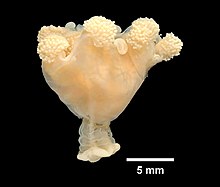Haliclystus auricula
| Haliclystus auricula | |
|---|---|

| |
| Scientific classification | |
| Domain: | Eukaryota |
| Kingdom: | Animalia |
| Phylum: | Cnidaria |
| Class: | Staurozoa |
| Order: | Stauromedusae |
| Family: | Haliclystidae |
| Genus: | Haliclystus |
| Species: | H. auricula
|
| Binomial name | |
| Haliclystus auricula Rathke, 1806
| |
| Synonyms | |
| |
Haliclystus auricula is a stalked jellyfish or Kaleidoscope jellyfish named for its shape resembling a funnel-shaped kaleidoscope that has eight arms typically found in the Northern Hemisphere. The Staurozoan is classified within the phylum Cnidaria under the kingdom Animalia.[1] Under its genus, H. auricula is considered the type species.[2]
Taxonomy
[edit]The defining morphological characteristic for H. auricula is the presence of a tentacular cluster of internal intertentacular lobules.[3] H. auricula also resembles another species called H. antarcticus and as a result of this many scientists go debate on whether or not they exhibit synonymy based on morphological features.[3] The scientific name is credited to James-Clark in 1863.[1] However, in 2010, Natural England, The Guardian and the Oxford University Museum of Natural History ran a competition asking members of the public to provide a common name for this species. The name "Kaleidoscope Jellyfish," submitted by Kepler Petzall, was eventually chosen.[4] Runner-up names included Fractal flower jellyfish and Mermaid's trumpet jellyfish.[4]
Description
[edit]H. auricula is 2-2.5cm tall and funnel shaped with a long stalk, a central mouth, and eight radiating arms that can have, at most, 100 kidney-shaped tentacles that are found at the tip that is an identifying feature for this species.[1] The coloring of H. auricula can range from a grey-ish green color to a reddish-brown color[1] and it is likely that they will often blend into the algae that they are attached to.[5] H. auricula is able to move location by attaching a specialized tentacle to the substrate as an anchor, detaching its base and 'cartwheeling' into the new position.[6]
Distribution
[edit]H. auricula is one of ten species of Haliclystus found in the Northern hemisphere.[7] Its presence has been noted off the coast of Greenland, Iceland, Portugal, France, Ireland, UK, Germany, northwestern US, around Gulf of St. Lawrence, Baltic Sea, North Sea,[3] and some appearances in the western hemisphere along the coast of South America (specifically Chile and Argentina)[5]. It is very sensitive to pollution. The populations along the British coastline are in decline.[6] Distribution includes the Shetland Isles, Orkney, western coast of England, Scotland and Ireland.[1]
Habitat
[edit]This species lives among the mid-eulittoral to shallow sublittoral ranges of an intertidal zone with the presence of adequate circulation for marine eelgrass and other algae.[1] H. auricula is often found attached to the variety of species of algae during the warmer months of the year, the algae are called suitable algae substrates.[5] The more favorable conditions for larval habitat would be similar: a large density of macroalgal species, which is dependent on wave action.[5] Depths they are found in range from mid-eulittoral to shallow sublittoral.[8]
Diet
[edit]Haliclystus auricula has been found to generally prey on species under the order of Copepods, Amphipods, Ostracods, and Isopods that are often around their attached algae within the intertidal zones.[9] A correlation between the size of the jelly and the type of prey is present, with smaller jellies consuming smaller species such as copepods whereas the larger species consumes a larger species like Amphipods.[9] In order to successfully ensnare their prey, this passive predator uses its stinging nematocysts.[9]
Lifecycle
[edit]This species was found to be most abundant and reproduce seasonally most frequently in through the spring and into the late summer, and die off sometime during the autumn.[5] Therefore, Like all stalked jellyfish, a single H. auricula individual is believed to live for only about one year.[10] And since this species is under the order Stauromedusae, this species reproduces by sexual or asexual means and their larval stage ranges between 2-10 days as a planula.[1]
References
[edit]- ^ a b c d e f g "MarLIN - The Marine Life Information Network - Kaleidoscope jellyfish (Haliclystus auricula)". www.marlin.ac.uk. Retrieved 3 March 2021.
- ^ Holst, Sabine; Heins, Anneke; Laakmann, Silke (29 April 2019). "Morphological and molecular diagnostic species characters of Staurozoa (Cnidaria) collected on the coast of Helgoland (German Bight, North Sea)". Marine Biodiversity. 49 (4): 1775–1797. doi:10.1007/s12526-019-00943-1. ISSN 1867-1616.
- ^ a b c Miranda, Lucília S.; Morandini, André C.; Marques, Antonio C. (17 June 2009). "Taxonomic review of Haliclystus antarcticus Pfeffer, 1889 (Stauromedusae, Staurozoa, Cnidaria), with remarks on the genus Haliclystus Clark, 1863". Polar Biology. 32 (10): 1507–1519. doi:10.1007/s00300-009-0648-8. ISSN 0722-4060.
- ^ a b "Natural England - Haliclystus auricula - Kaleidoscope jellyfish". Archived from the original on 12 March 2012. Retrieved 1 August 2010.
- ^ a b c d e Zagal, Carolina J. (1 April 2004). "Population biology and habitat of the stauromedusa Haliclystus auricula in southern Chile". Journal of the Marine Biological Association of the United Kingdom. 84 (2): 331–336. doi:10.1017/S0025315404009233h. ISSN 0025-3154.
- ^ a b "The beautiful, coral-like jellyfish: Haliclystus auricula". The Guardian. 25 June 2010.
- ^ Miranda, Lucília S.; Morandini, André C.; Marques, Antonio C. (2009). "Taxonomic review of Haliclystus antarcticus Pfeffer, 1889 (Stauromedusae, Staurozoa, Cnidaria), with remarks on the genus Haliclystus Clark, 1863". Polar Biology. 32 (10): 1507. doi:10.1007/s00300-009-0648-8.
- ^ "Staromedusea". www.marlin.ac.uk. Retrieved 3 March 2021.
- ^ a b c Zagal, Carolina J. (1 April 2004). "Diet of the stauromedusa Haliclystus auricula from southern Chile". Journal of the Marine Biological Association of the United Kingdom. 84 (2): 337–340. doi:10.1017/S0025315404009245h. ISSN 0025-3154.
- ^ Corbin, P. G. (1979). "The seasonal abundance of four species of Stauromedusae (Coelenterata: Scyphomedusae) at Plymouth". Journal of the Marine Biological Association of the United Kingdom. 59 (2): 385–391. doi:10.1017/S0025315400042697.
